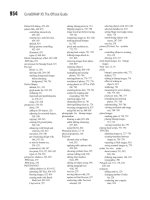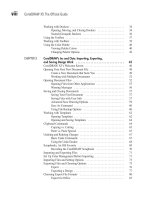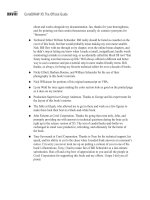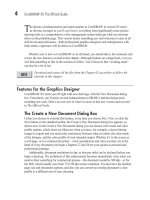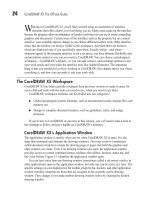CorelDRAW X5 The Official Guide part 41 pptx
Bạn đang xem bản rút gọn của tài liệu. Xem và tải ngay bản đầy đủ của tài liệu tại đây (568.08 KB, 10 trang )
In either case, the text can be made to flow down the left or right of the object, or
straddle it (flow down both sides). Square wrapping also supports Above/Below, where no
text flows to the sides of the object.
To apply Contour Straddle, right-click the shape and select Wrap Paragraph Text from
the pop-up menu. To set a different wrapping type, select it from the General tab of the
Object properties docker (press
ALT+ENTER). Then set the margin distance, which is the gap
between the outline or bounding box of the shape and the paragraph text wrapped around it.
Grouped objects will accept Contour Straddle, but not all complex objects will. For
example, if you want to straddle text around a blend group, group the blend objects
first, or the Wrap Paragraph Text option will be dimmed.
364 CorelDRAW X5 The Official Guide
FIGURE 12-12 There are six contour and square text-wrapping options available and one non-
wrapping option (None).
It’s important to understand that text legibility can be at peril when you wrap text around
a highly freeform shape; it’s just not good layout, for example, to create a zigzag-shaped
wrap, causing the reader’s head to whiplash every other line. Use wrapping text as a creative
element, but use your artistic eye to avoid unnecessarily hard-to-read paragraph text.
Wrapping affects only paragraph text. Text wrapping is not applied to the wrapped
text itself, only to the shapes that are wrapped by the text.
Fitting Text to Curve
Wrapping text around an object has its alter ego: putting text inside a shape, so it looks as
though the text itself forms a shape. And there’s a third variation called Fit Text To Curve—
CHAPTER 12: Getting Artistic with Text 365
12
you can have artistic text follow an arc, a freeform line, an open or closed shape, and you
have options for the style in which the text follows your line.
Pouring Text into a Shape
The simplest way to form text so it appears to have a geometry other than rectangular, is to
first create a shape, copy some text to the Clipboard if you don’t have a message in mind,
and then carefully position your Text tool just inside the line of the shape (perhaps 1/8 of a
screen inch inside) until the cursor turns into an I-beam with a tiny text box at its lower
right, and then click to start typing, or click and then press
CTRL+V to paste your Clipboard
text. Text inside a shape is paragraph text, and it obeys all the paragraph text formatting
conventions covered in this chapter. Here’s an example of a creative use for shaped
paragraph text: the following mock article is about buttons, so the shape of the paragraph
text might look appropriate if it was shaped like…a button.
Creating a Round Text Frame
1. Open Sew what.cdr in CorelDRAW. The text has been provided for you in the
margin.
2. With the Ellipse tool (F7) hold CTRL to constrain the ellipse to a circle, and then drag
a shape in the document about 6" in width. Check the property bar if necessary to
get an approximation of the 6" circle.
3. Copy the text at left to the Clipboard. It’s easiest to do this with the Pick tool; the
Text tool can also be used. Highlight the text and then press
CTRL+C to copy or
CTRL+X to cut.
4. With the Text tool, hover the cursor just inside the circle until it turns into an I-beam
cursor with a tiny “AB” to the bottom right, and then click. Do not click if the cursor
features an “A” with a wavy line—this is the indication that you can put text along a
curve, the wrong feature for this example. With the insertion point for text inside the
circle, you could start typing, but for these steps, press
CTRL+V to paste text from the
Clipboard.
366 CorelDRAW X5 The Official Guide
5. Choose Text | Paragraph Formatting. If you’d created a half-circle into which you poured
the text, it would not obscure the headline in this example. However, the text doesn’t fill
the circle container, so you can align the text to the bottom of the circle: choose Bottom
from the Alignment | Vertical drop-down list on the Paragraph formatting docker.
6. With the text selected, choose an appropriate typeface from your list of installed
fonts, accessed from the property bar. Then choose a font size of your liking. Times
New Roman—a Windows system font—works quite well for this short text passage
at 18 points.
7. If the text proves to be too large in point height, resize the container using the Pick
tool—hold
SHIFT to contain the scaling, and magically the text reflows dynamically
until you release the object. You don’t always need to scale text; sometimes scaling
the text’s container is a more inspired way to finish a design.
8. Make the circle containing the text invisible: select the circle with the Pick tool
(check the status line to make sure the circle and not the text is selected), and then
right-click the no outline well on the color palette, the top one with the “X” in it.
Figure 12-13 shows the assignment nearing completion.
CHAPTER 12: Getting Artistic with Text 367
12
One very popular treatment for text “bound” to an object is the arc of text. This is
accomplished by first creating the arc shape (a circle usually works well) and then instead of
clicking inside the shape, hovering your cursor above the shape until your Text tool cursor
becomes an I-beam with a tiny swooping curve beneath it.
Follow these steps to flow text in a semicircle.
Text Along a Curve
1. Open Loving Cup.cdr. The graphic of the trophy could use some text surrounding
the top.
2. Create a circle using the Ellipse tool.
368 CorelDRAW X5 The Official Guide
FIGURE 12-13 Create visual gestalt! Make your text look like the graphic.
3. With the Shape tool, drag the Ellipse node away from the center of the circle to
create an open arc. Adjust each node until you have an arc centered above the loving
cup. See Chapter 8 if you’re unfamiliar with editing CorelDRAW objects.
4. With the Text tool, position the cursor just along the outline of the circle, and then
click an insertion point and begin to type. You’ll see that the text follows the curve.
What you type is up to you, but “Congratulations” is a solid starter for graphics that
involve a trophy!
5. If the text isn’t aligned to your liking, use the Offset spin box on the property bar to
correct it.
6. If you’d like the text to be a little off the curve, use the Distance From Path spin box.
7. If you’d like a truly wild and interesting style, a treatment of the text such as a 3D
ribbon look, check out the drop-down list at left on the property bar. Click any of the
styles to apply them. Figure 12-14 shows an example of an award; the circle still has
an outline, but it takes one right-click to correct that.
CHAPTER 12: Getting Artistic with Text 369
12
FIGURE 12-14 Use Fit Text To Curve to make your message a flowing one.
Distance From Path
Offset
Styles
Embedding Objects into Text
Graphic objects and bitmaps can be embedded into blocks of artistic and paragraph text—in
the layout profession, this is called an inline graphic. This is great for adding special
symbols to text such as logotypes, bullet points, or horizontal separators, or for embedding
instructional graphics such as mouse cursor images.
You embed an object into text in two ways:
●
With the Clipboard Copy or cut the object to the Clipboard (CTRL+C or
CTRL+X), click the Text tool in the text where you want the object to be placed,
and paste the object (
CTRL+V).
●
Drag-and-Drop Select the object with the mouse, and then drag it with the right
mouse button to the position in the text where you want it to appear—a vertical bar
between characters in the text indicates where the object will be placed. Release the
mouse button and select Copy Into Text or Move Into Text from the pop-up menu.
Embedded objects are treated as “special characters”—they can be selected only with
the Text tool or the Shape tool. To resize an object after it has been embedded, select it and
set its point size on the property bar as if it were a typographic character.
To delete an embedded object, select it with the Text tool and press
DELETE.
Changing and Proofing Formatted Text
Once you have your text formatted the way you want, it’s still editable text; if you’ve entered
it by hand, you should probably proof it before sending it off for printing. There’s no equity
in 12,000 four-color posters that proudly exclaim, “Enter The Millyun Dollar Speling
Contest!”, right? Proofing for spelling and grammar is easy: you select the text with either
the Pick or the Text tool, and then press
CTRL+F12 (or right-click and then choose Spell
Check from the pop-up menu). You’ll see that you have not only a spelling, but also a
grammar checker and a thesaurus right there at your cursor tip.
Spell checking is only one area of CorelDRAW that you can use to put the finishing
touches on your text message; the following sections take you through other features and a
little text preflight for your work.
Changing Text Case
Occasionally you’ll receive text from a client who doesn’t know where the CAPS LOCK key
is on the keyboard, or you have a really, really old plain-text file created using a DOS
application. In any event, using all caps in a text message, unless it’s a very brief headline,
can be a real eyesore.
370 CorelDRAW X5 The Official Guide
To change the case of text you have typed, insert the Text tool cursor in text, and then
right-click the text: choose an option from the Change Case submenu. Changing the case of
characters replaces the original characters with new characters of the correct case.
Hyphenation
It’s bad form to have two or more consecutive lines of text with a hyphen at the end, and this
sometimes happens when you use a specific column width or frame shaping.
●
To remove hyphenation from a paragraph, choose the text with either the Pick tool or
the Text tool, then choose Text, and then uncheck Use Hyphenation.
●
To manually hyphenate a line after hyphenation is turned off, you can put your
cursor between the characters you want to break and then press
CTRL+
Alternatively, click the insertion point with the Text tool, and then choose Text |
Insert Formatting Code | Optional Hyphen.
Converting Paragraph Text to Curves
It is possible to convert paragraph text to curves. By converting text to curves, the resulting
shapes can be extensively modified, reshaped, and restyled. This is also a method for
preventing others from making any text modifications to the document. It is also an
acceptable way to prepare text-heavy illustrations for sharing when you’re confident that a
coworker doesn’t own a font you used in the document.
To convert a paragraph text object to curves, select it and choose Arrange | Convert To
Curves. Or, right-click the text object with the Pick tool, and choose Convert To Curves
from the pop-up menu or press
CTRL+Q. Because paragraph text as curves can have
thousands of nodes, don’t perform this sort of thing thoughtlessly, and be prepared to wait a
while during the conversion of large paragraphs. CorelDRAW converts paragraph text to
curves quite intelligently; it breaks the text into groups, groups almost never consisting of a
single shape that has more than 1,000 nodes. PostScript printing language has a complexity
threshold of 1,000–1,200 nodes along a single path. If you ever arrive at a single curve shape
that has more than this amount, you’re best off breaking the shape (Arrange | Break Curve
Apart;
CTRL+K) and then joining shapes that should be joined (Arrange | Combine; CTRL+L).
Too many nodes, and a PostScript job will fail, and a commercial printer is not likely to
thank you for your business.
Text and Styles
After you’ve created a specific look for text, it would be a shame not to be able to save it as a
style so it can be reused later. You can create styles for artistic and paragraph text in CorelDRAW.
Styles store the text attributes from one object and can be used to apply those attributes to other
CHAPTER 12: Getting Artistic with Text 371
12
objects at a later time in the same document (styles are by default local properties). If you edit
the properties of a style, all the text formatted with that style is updated immediately.
To save a style, with the Pick tool, choose the text, right-click, and then choose Styles |
Save Style Properties, and you’ll get a box that looks like the following illustration. This box
is valid for objects as well; object styles can also be applied for fill and outline settings.
Creating and Editing Styles
In the Save Style As dialog, only select those formatting options that you want as part of the
style. If, for example, you select the Text option but clear the Fill and Outline options, then
applying this new style to some text will only modify the type-related properties and will
keep the existing fill and outline.
Give the style a new, unique name. Click OK, and the style is created and ready for use
on the Graphic and text styles docker, which is opened by pressing
CTRL+F5 or by choosing
Window | Dockers | Graphic And Text Styles. You drag the title of your saved style and drop
it onto a text object you want formatted. Alternatively, right-click the text object and choose
Styles | Apply in the pop-up menu; then choose the style you want from the list.
Editing Text Styles
To edit a style, right-click its title on the Graphic and text styles docker, and then choose
Properties. This opens the Options dialog at the Styles page under Document, with the style
selected in the list, from where you can enable and disable features of the style. You can also
edit the settings of the style by clicking the Font, Fill, or Outline Edit button in the Options
dialog.
To delete a style from the docker, right-click it and choose Delete. You cannot delete
default styles.
372 CorelDRAW X5 The Official Guide
To revert some text to its assigned style, either reapply the style, or right-click and
choose Styles | Revert To Style from the pop-up menu.
You have in front of you a very handy and thorough documentation of how to make a
text message stand out in the marketplace—how to attract attention in a polished, professional
manner. From drop caps to justification, leading to indents, these aren’t just a typographer’s
tools, but the tools of everyone who needs to communicate visually. After a while, what you
used to consider an extraordinary effort to accomplish with text will feel quite natural and
even ordinary. Now that you know how to drive CorelDRAW’s text engine, let’s learn the
rules of the road in Chapter 13. Fonts are like any artistic element: there are wise and poor
uses for typefaces, and you’ll want your message to read as well as it looks.
CHAPTER 12: Getting Artistic with Text 373
12
